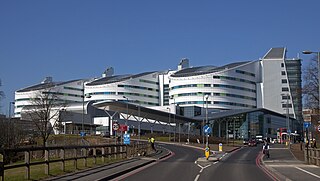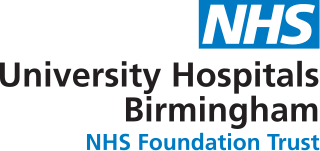
The University of Birmingham is a public research university located in Edgbaston, Birmingham, United Kingdom. It received its royal charter in 1900 as a successor to Queen's College, Birmingham, and Mason Science College, making it the first English civic or 'red brick' university to receive its own royal charter. It is a founding member of both the Russell Group of British research universities and the international network of research universities, Universitas 21.

Prince of Wales Hospital is a large of Tertiary referral hospital and large of teaching hospital from Faculty of Medicine in Chinese University of Hong Kong in Sha Tin, New Territories in Hong Kong..

The Queen's Medical Centre is a teaching hospital situated in Nottingham, England. Until February 2012, when it was surpassed by the Royal London Hospital, it was the largest hospital in the United Kingdom, though its remains the largest major trauma centre in England. It is managed by Nottingham University Hospitals NHS Trust.

St James's University Hospital is in Leeds, West Yorkshire, England and is popularly known as Jimmy's. It is one of the United Kingdom's most famous hospitals due to its coverage on television. It is managed by the Leeds Teaching Hospitals NHS Trust.

St George's Hospital is a large teaching hospital in Tooting, London. Founded in 1733, it is one of the UK's largest teaching hospitals and one of the largest hospitals in Europe. It is run by the St George's University Hospitals NHS Foundation Trust. It shares its main hospital site in Tooting in the London Borough of Wandsworth, with St George's, University of London, which trains NHS staff and carries out advanced medical research.

Sir Charles Gairdner Hospital (SCGH) is a teaching hospital in Nedlands, Western Australia.

Saint Mary's Hospital is a hospital in Manchester, England. It is part of Manchester University NHS Foundation Trust. Founded in 1790, St Mary's provides a range of inter-related services specifically for women and children.

The Queen Elizabeth Hospital Birmingham is a major, 1,215 bed, tertiary NHS and military hospital in the Edgbaston area of Birmingham, situated very close to the University of Birmingham. The hospital, which cost £545 million to construct, opened on 16 June 2010, replacing the previous Queen Elizabeth Hospital and Selly Oak Hospital. It is one of the largest single-site hospitals in the United Kingdom and is part of one of the largest teaching trusts in England.

The University of Birmingham Medical School is one of Britain's largest and oldest medical schools with over 400 medical, 70 pharmacy, 140 biomedical science and 130 nursing students graduating each year. It is based at the University of Birmingham in Edgbaston, Birmingham, United Kingdom. Since 2008, the medical school is a constituent of The College of Medical and Dental Sciences.

Queen Elizabeth Hospital in King's Lynn, Norfolk, England. It is located on the outskirts of King's Lynn, to the eastern edge of the town. The catchment area of the Queen Elizabeth Hospital covers the West Norfolk area, South Lincolnshire and Northern part of Fenland District, Cambridgeshire, an area of approximately 1500 km2 and 250,000 people. It is managed by the Queen Elizabeth Hospital King's Lynn NHS Foundation Trust. The Queen Elizabeth Hospital is named after Queen Elizabeth The Queen Mother, rather than Queen Elizabeth II.

Manchester Royal Infirmary (MRI) is a large NHS teaching hospital in Chorlton-on-Medlock, Manchester, England. Founded by Charles White in 1752 as part of the voluntary hospital movement of the 18th century, it is now a major regional and national medical centre. It is the largest Hospital within Manchester University NHS Foundation Trust, and based on its Oxford Road Campus in South Manchester where it shares a site with the Royal Manchester Children's Hospital, Manchester Royal Eye Hospital and Saint Mary's Hospital as well as several other educational and research facilities. The Hospital is also a key site for medical educational within Manchester, serving as a main teaching hospital for School of Medical Sciences, University of Manchester.

The University Hospitals Birmingham NHS Foundation Trust provides adult district general hospital services for Birmingham as well as specialist treatments for the West Midlands.

The Royal Infirmary of Edinburgh (RIE), often known as the Edinburgh Royal Infirmary (ERI), was established in 1729 and is the oldest voluntary hospital in Scotland. The new buildings of 1879 were claimed to be the largest voluntary hospital in the United Kingdom, and later on, the Empire. The hospital moved to a new 900 bed site in 2003 in Little France. It is the site of clinical medicine teaching as well as a teaching hospital for the University of Edinburgh Medical School. In 1960, the first successful kidney transplant performed in the UK was at this hospital. In 1964, the world's first coronary care unit was established at the hospital. It is the only site for liver, pancreas and pancreatic islet cell transplantation and one of two sites for kidney transplantation in Scotland. In 2012, the Emergency Department had 113,000 patient attendances, the highest number in Scotland. It is managed by NHS Lothian.

Selly Oak Hospital was situated in the Selly Oak area of Birmingham, England. Previously managed by the University Hospitals Birmingham NHS Foundation Trust, the hospital closed in 2011.

Stobhill Hospital is an Ambulatory Care and Diagnostic Hospital, located in Springburn in the north of Glasgow, Scotland. It serves the population of North Glasgow and part of East Dunbartonshire. It is managed by NHS Greater Glasgow and Clyde.

The Cambridge Biomedical Campus is the largest centre of medical research and health science in Europe. The site is located at the southern end of Hills Road in Cambridge, England.
TheQueen Elizabeth Hospital (TQEH) is an acute care teaching hospital in the western suburbs of Adelaide, South Australia. It provides a range of health services, including inpatient, outpatient, surgical, emergency and mental health services.

The University Hospital of South Manchester NHS Foundation Trust is a defunct NHS foundation trust that previously operated Wythenshawe Hospital, a major acute teaching hospital in Wythenshawe, Manchester. Many of the services and facilities previously at Withington Hospital were transferred to Wythenshawe in 2004. It provided services for adults and children at Wythenshawe Hospital and Withington Community Hospital. It runs Buccleuch Lodge Intermediate Care Unit and the Dermot Murphy Centre in Withington, and the Specialised Ability Centre in Sharston.

Leeds Teaching Hospitals NHS Trust is an NHS hospital trust in Leeds, West Yorkshire, England.
University College London Hospitals NHS Foundation Trust (UCLH) is an NHS foundation trust based in London, United Kingdom. It comprises University College Hospital, University College Hospital at Westmoreland Street, the UCH Macmillan Cancer Centre, the Royal National ENT and Eastman Dental Hospitals, the Hospital for Tropical Diseases, the National Hospital for Neurology and Neurosurgery, the Royal London Hospital for Integrated Medicine and the Royal National Throat, Nose and Ear Hospital.





















